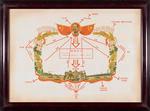A Pictorial Study of Marriage Certificates in the New China
Chen Mingqiang
陈明强
Production date
2013
Object Detail
Media
dissertation documents
Measurements
16 volumes
20 framed marriage certificates
20 framed marriage certificates
Notes
Chen Mingqiang’s postgraduate research examined how love and marriage has been visually represented in modern China, through the iconography of marriage certificates. A Pictorial Study of Marriage Certificates in the New China (2013) was his dissertation. Thinking about his impending marriage, he became curious about the ways changing social attitudes were reflected in visual culture. Searching through flea markets and recycling centres, he collected four hundred and forty official marriage certificates dating from 1949 to the present day. From these finds he produced sixteen bound volumes of illustrated documents that reveal China’s changing attitudes to gender, love, and family. Marriage was not a private affair in China after 1949 and the certificate recording the event was a vehicle of state propaganda. Depending on social circumstances and policy directions in the year of the marriage, an official marriage certificate might depict happy peasants and factory workers, a bumper harvest, or a Soviet-made tractor. In the early 1950s, the visual code representing the betrothed couple might be a pair of peonies, whilst during the Cultural Revolution images of Mao Zedong dominated, an unmistakeable statement of duty to country and collective nation-building. After Mao’s death, during China’s reform and opening period, marriage certificates were less decorative, becoming purely functional bureaucratic documents.
Chen Mingqiang used the certificates as primary sources for a semiotic analysis; he examined their context, patterns, typography, layout, colour — every aspect of their design and content, and their social, historical and economic context. As ‘found objects’ of Chen’s ethnographic study of social attitudes, the certificates are presented in a museum vitrine, like artefacts of a lost world that illustrate the disjunction between the different domains of past and present. When the People’s Republic of China was established in 1949, Mao Zedong banned concubinage, foot binding and arranged marriage. The new marriage law was passed in May 1950 and provided a civil registry for legal marriages. The marriageable age was raised to twenty for men and eighteen for women. The change in marriage law was also, importantly, a key element in the Communist land reform program, as women could no longer be bought and sold to landlords in payment for debts.
Chen Mingqiang used the certificates as primary sources for a semiotic analysis; he examined their context, patterns, typography, layout, colour — every aspect of their design and content, and their social, historical and economic context. As ‘found objects’ of Chen’s ethnographic study of social attitudes, the certificates are presented in a museum vitrine, like artefacts of a lost world that illustrate the disjunction between the different domains of past and present. When the People’s Republic of China was established in 1949, Mao Zedong banned concubinage, foot binding and arranged marriage. The new marriage law was passed in May 1950 and provided a civil registry for legal marriages. The marriageable age was raised to twenty for men and eighteen for women. The change in marriage law was also, importantly, a key element in the Communist land reform program, as women could no longer be bought and sold to landlords in payment for debts.
Accession number
2013.165

